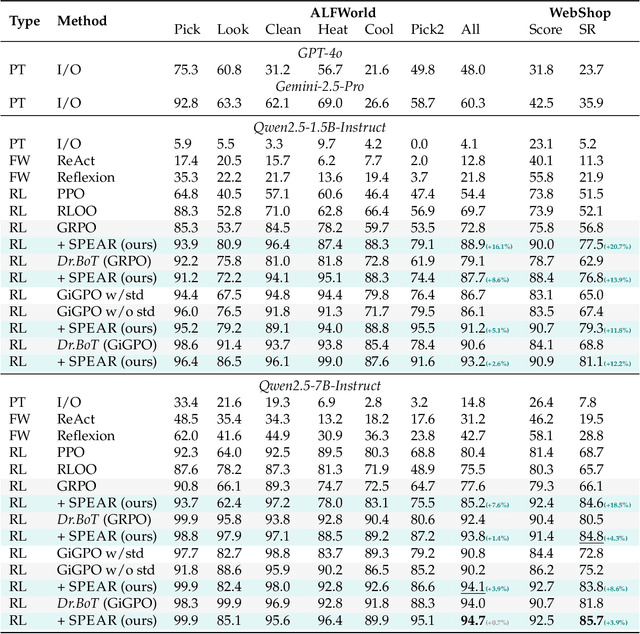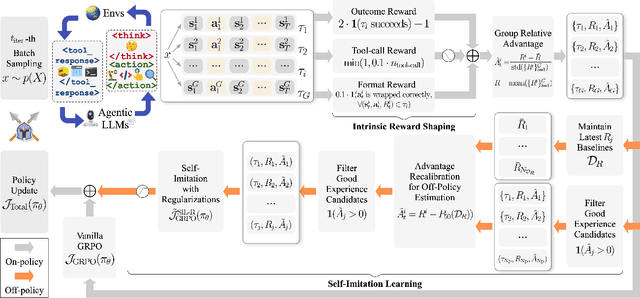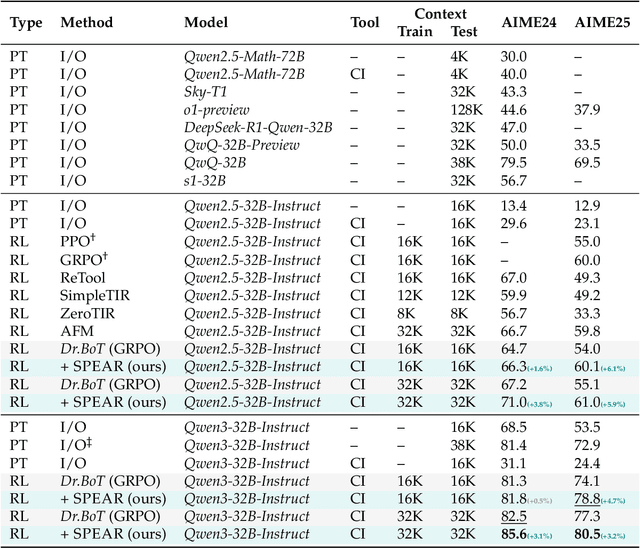Yuzheng Cai
Learn the Ropes, Then Trust the Wins: Self-imitation with Progressive Exploration for Agentic Reinforcement Learning
Sep 26, 2025



Abstract:Reinforcement learning (RL) is the dominant paradigm for sharpening strategic tool use capabilities of LLMs on long-horizon, sparsely-rewarded agent tasks, yet it faces a fundamental challenge of exploration-exploitation trade-off. Existing studies stimulate exploration through the lens of policy entropy, but such mechanical entropy maximization is prone to RL training instability due to the multi-turn distribution shifting. In this paper, we target the progressive exploration-exploitation balance under the guidance of the agent own experiences without succumbing to either entropy collapsing or runaway divergence. We propose SPEAR, a curriculum-based self-imitation learning (SIL) recipe for training agentic LLMs. It extends the vanilla SIL framework, where a replay buffer stores self-generated promising trajectories for off-policy update, by gradually steering the policy evolution within a well-balanced range of entropy across stages. Specifically, our approach incorporates a curriculum to manage the exploration process, utilizing intrinsic rewards to foster skill-level exploration and facilitating action-level exploration through SIL. At first, the auxiliary tool call reward plays a critical role in the accumulation of tool-use skills, enabling broad exposure to the unfamiliar distributions of the environment feedback with an upward entropy trend. As training progresses, self-imitation gets strengthened to exploit existing successful patterns from replayed experiences for comparative action-level exploration, accelerating solution iteration without unbounded entropy growth. To further stabilize training, we recalibrate the advantages of experiences in the replay buffer to address the potential policy drift. Reugularizations such as the clipping of tokens with high covariance between probability and advantage are introduced to the trajectory-level entropy control to curb over-confidence.
SimGRAG: Leveraging Similar Subgraphs for Knowledge Graphs Driven Retrieval-Augmented Generation
Dec 17, 2024



Abstract:Recent advancements in large language models (LLMs) have shown impressive versatility across various tasks. To eliminate its hallucinations, retrieval-augmented generation (RAG) has emerged as a powerful approach, leveraging external knowledge sources like knowledge graphs (KGs). In this paper, we study the task of KG-driven RAG and propose a novel Similar Graph Enhanced Retrieval-Augmented Generation (SimGRAG) method. It effectively addresses the challenge of aligning query texts and KG structures through a two-stage process: (1) query-to-pattern, which uses an LLM to transform queries into a desired graph pattern, and (2) pattern-to-subgraph, which quantifies the alignment between the pattern and candidate subgraphs using a graph semantic distance (GSD) metric. We also develop an optimized retrieval algorithm that efficiently identifies the top-$k$ subgraphs within 1-second latency on a 10-million-scale KG. Extensive experiments show that SimGRAG outperforms state-of-the-art KG-driven RAG methods in both question answering and fact verification, offering superior plug-and-play usability and scalability.
Results of the Big ANN: NeurIPS'23 competition
Sep 25, 2024



Abstract:The 2023 Big ANN Challenge, held at NeurIPS 2023, focused on advancing the state-of-the-art in indexing data structures and search algorithms for practical variants of Approximate Nearest Neighbor (ANN) search that reflect the growing complexity and diversity of workloads. Unlike prior challenges that emphasized scaling up classical ANN search ~\cite{DBLP:conf/nips/SimhadriWADBBCH21}, this competition addressed filtered search, out-of-distribution data, sparse and streaming variants of ANNS. Participants developed and submitted innovative solutions that were evaluated on new standard datasets with constrained computational resources. The results showcased significant improvements in search accuracy and efficiency over industry-standard baselines, with notable contributions from both academic and industrial teams. This paper summarizes the competition tracks, datasets, evaluation metrics, and the innovative approaches of the top-performing submissions, providing insights into the current advancements and future directions in the field of approximate nearest neighbor search.
 Add to Chrome
Add to Chrome Add to Firefox
Add to Firefox Add to Edge
Add to Edge